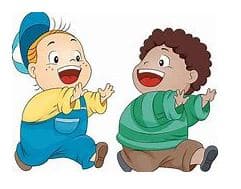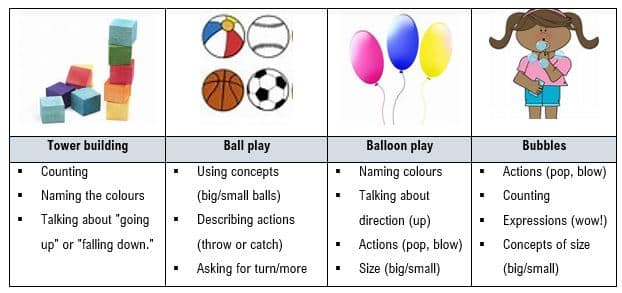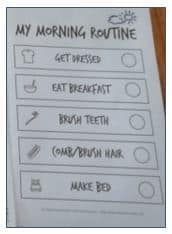
28 April 2020 – YOU CAN SUPPORT your child to learn that language can be fun and exciting, especially when it involves activities that he or she loves!
You will also discover that everyday activities and routines can provide many language opportunities for your child.
- What are your language goals for your child?
- Do they involve your child using sounds, words, gestures, action or pictures, to tell you what they want?
- Maybe you would like your child to respond to instructions such as completing the steps of the morning routine or perhaps answering simple questions?
- Perhaps you would like to see your child use more natural language while playing with you or their siblings?
Whatever the goals may be, your everyday activities and routines are golden opportunities for your child to practice those skills. You already know many ways to motivate your child, and you are in the best possible position to encourage your child to learn new language skills.
Embrace Your Child’s Interest
Stacey, mum of Taika, knows that her son loves looking through books. She uses this as an opportunity for him to learn new words and share his ideas with her. I asked Stacey to tell us what it is that she is doing to make this interaction so successful:
“I realise I get more interaction with my son if I point things out in the pictures instead of just reading the words. I try to pay real attention to him as I do, following his lead when he wants to turn the pages, labelling and describing things he points out or copying things he says. If I see that he understands a concept, I try and expand on it, e.g. when he points out a hippo, I say, “yeah, hippo, yellow hippo.’’
You know your child the best! So, when you notice that your child is playing with a favourite toy or singing a favourite song, get ready to join in!
- Come closer – Get down to his or her level or sit beside him or her.
- Pay attention – Notice what it is that draws your child to this activity – is it the movement (e.g., spinning, running, pushing, clicking) or the sounds and words (e.g. the noise the toy makes or the sound out the words of a book)?
- Respond to these actions, sounds or words, by copying them, i.e. do what your child does or says and pause a moment to see what happens.
- Talk about what your notice, e.g., name or describe what your child is playing with, and pause to see if he notices.
You will find that, when you join in on what is already happening, it is easier for your child to shift their focus to include you. Your child will be more receptive to copying you when you use their interest as a starting point for interaction!
Play Games with Predictable Language
Remember those games and songs you repeatedly played or sang as a child? Why do we remember these games? 
You can create your own favourite games with your child because you already know what will keep him engaged! Perhaps your child adores cuddles and squeezes. How can you create a game with cuddles or squeezes, that will involve asking to, “squeeze me”? Here are a few steps you can follow to make this game predictable and fun.
- Think about the steps in the game – what language or actions will you use?
- Play this game many times so your child can learn the steps and the words.
- Include fun phrases such as, “ready, set, go” or use tunes to songs your child knows.
- Emphasise the words “squeeze me” each time you give your child a huge cuddle!
- Consider at which point your child will contribute to this game – will you wait for your child to say, “squeeze me,” before you cuddle him or her?
Here are some more games that you can create, to encourage your child’s language skills.
Give a Voice to your Child’s Ideas
Your child may already be trying to communicate messages to you in ways you are not expecting, or you may not know what they are trying to tell you. It is essential that you acknowledge these attempts, as it is likely your child will do this again if he was successful in getting his message across! Perhaps your child is pulling you by the hand without looking towards you. What is the message you think your child is sending you? Give a voice to your child’s message by:
- Saying what you think your child is trying to communicate, e.g., “I think you want me to come!”
- Saying the words from your child’s perspective, e.g., “come mum!”
- Pointing to a picture or a symbol and explain, “come! You want me to come!”
- Signing the word or use the gesture while saying, “come”.
When you do this, you are validating your child’s message to you, and you are demonstrating to your child what a powerful tool language can be!
Note: Pictures, symbols, signs, gestures, and objects can offer children another way to express their needs, while they are learning how to make sounds. Choose a tool that is easy for your family to use frequently and have these available to your child all day long. Place them in places where your child can access them anytime. Visuals tools are always used alongside our spoken language.
Take Advantage of Everyday Routines
Children learn new skills through lots of repetition and practice! When you dress, feed, bath your child, or brush their teeth, you help them learn the meaning of words, how to respond to directions and how to pay attention and participate in the steps.
Adeleine, mum of JJ, shares with us how she helps JJ understand what needs to be done in the morning routine:
“I made this for JJ and put it down with his breakfast. I warn him 5 minutes before we get dressed and brush hair and teeth. Always after he finishes his food. The house also stays locked until everything is done. I will then say “time to get dressed” with his clothes in my hands. I put them down and wait for a response. I will repeat that after a minute and wait. Then I will ask if he needs help. Then I say, “JJ do it, or mamma do it?” I wait about a minute each time. He has been responding at first or second ask. He has even been asking to pick different clothes too.”
Each time you go through your routines of dressing, mealtimes, bath time, toileting, or tidying up:
- Try to use words that describe what you are doing.
- Be as specific and concise as possible.
- Emphasise or highlight words that you think is important for your child to know.
- Keep using the same words each time, so your child can associate them to this context.
- Show your child what you mean, by pointing or demonstrating.
It is essential that you allow enough time for these routines. Your child may need time to process the words you are using. You may need to give your child time to do what you are asking him to do! This will ensure your child is successful!
Visual tools, such as the one Adeleine created (pictures schedules, tasks lists, reward charts, token systems, symbols) help us make our words stand out. Alongside spoken words, visuals can help a child understand the meaning of words. They assist with organisational skills and support independence in any of your self-care routines.
Language (spoken, written or signed) gives us a vehicle with which we express our ideas and needs to others. It also helps us make sense of the world and opens new opportunities. Make the most of your everyday routines and activities to help your child learn to use this powerful vehicle!
- Estelle Pretorius is a speech language therapist at McKenzie Centre in Hamilton.
- She qualified as a speech language therapist at the University of Pretoria in South Africa, before relocating to New Zealand in February 2007.
- Estelle has a strong interest in the field of family capacity building practice and collaborative interventions.
- She is a member of the Altogether Autism Professional Advisory Group.




